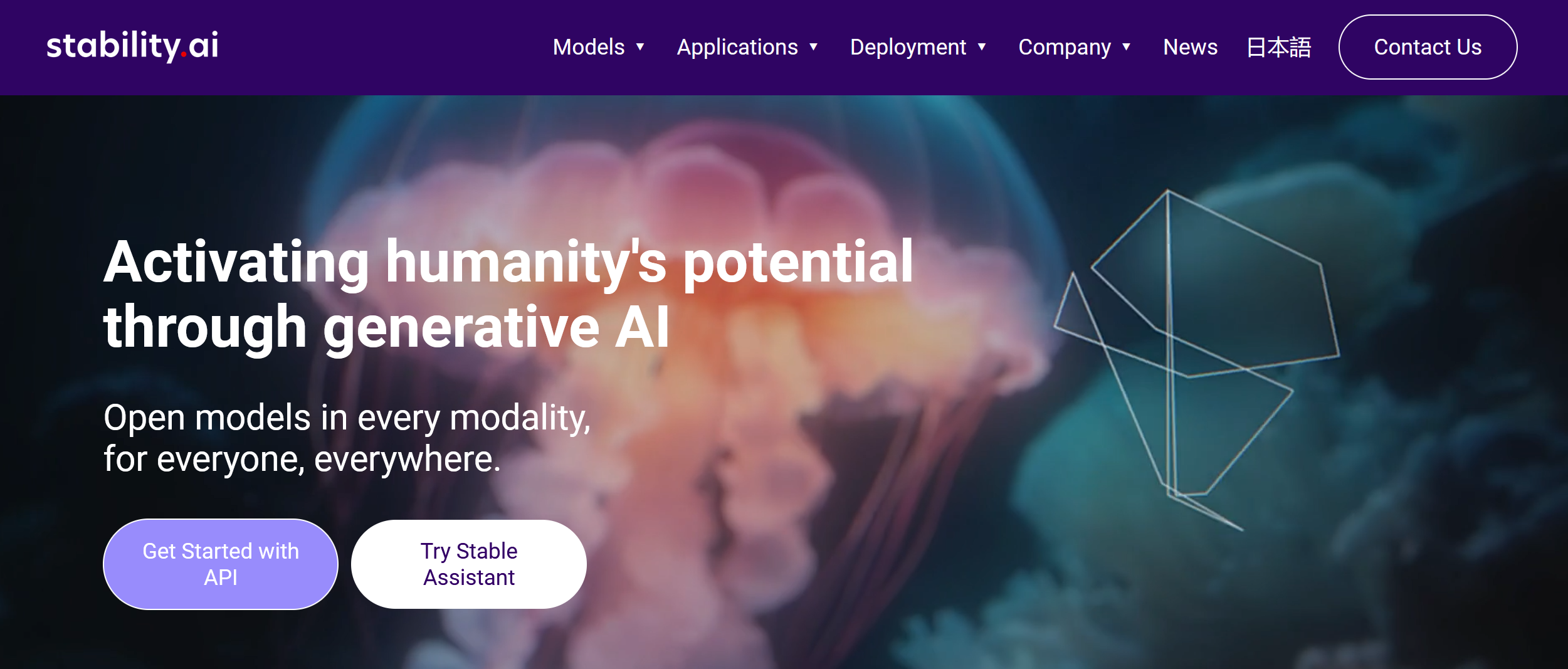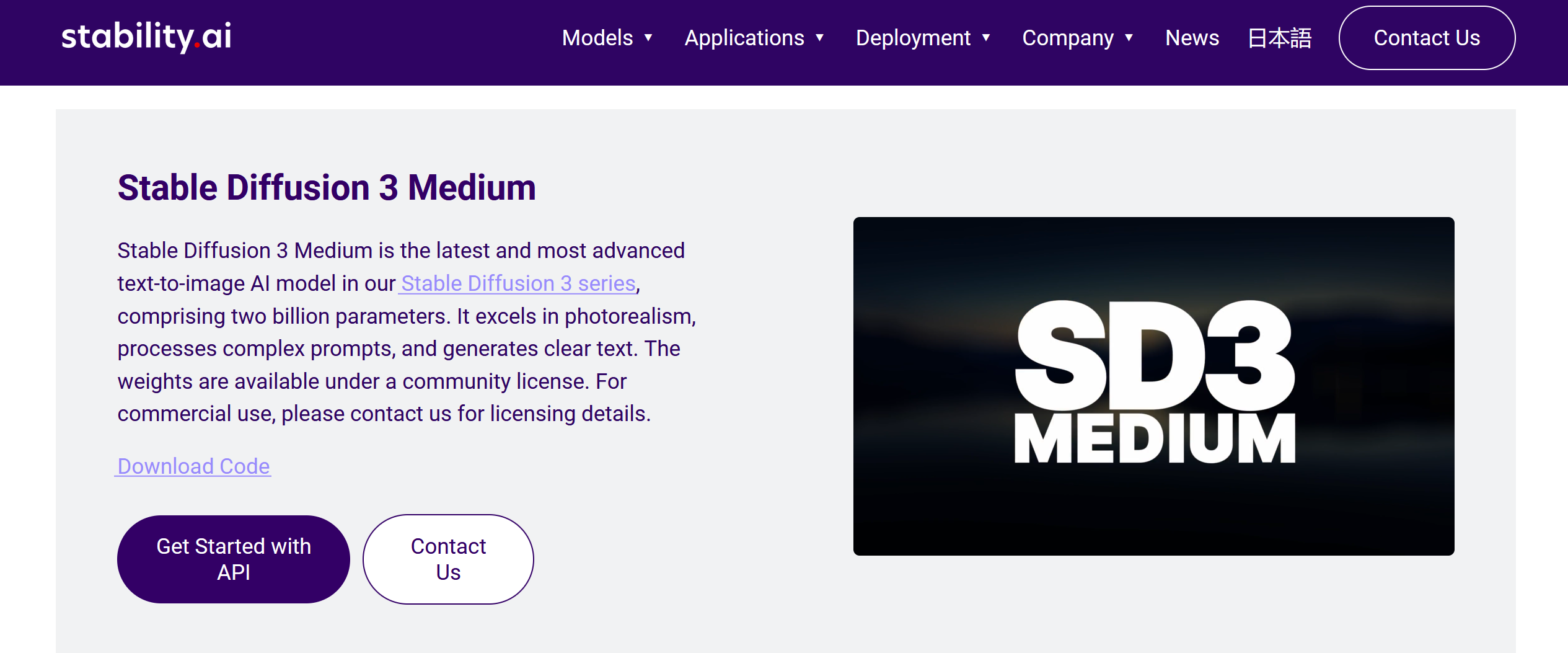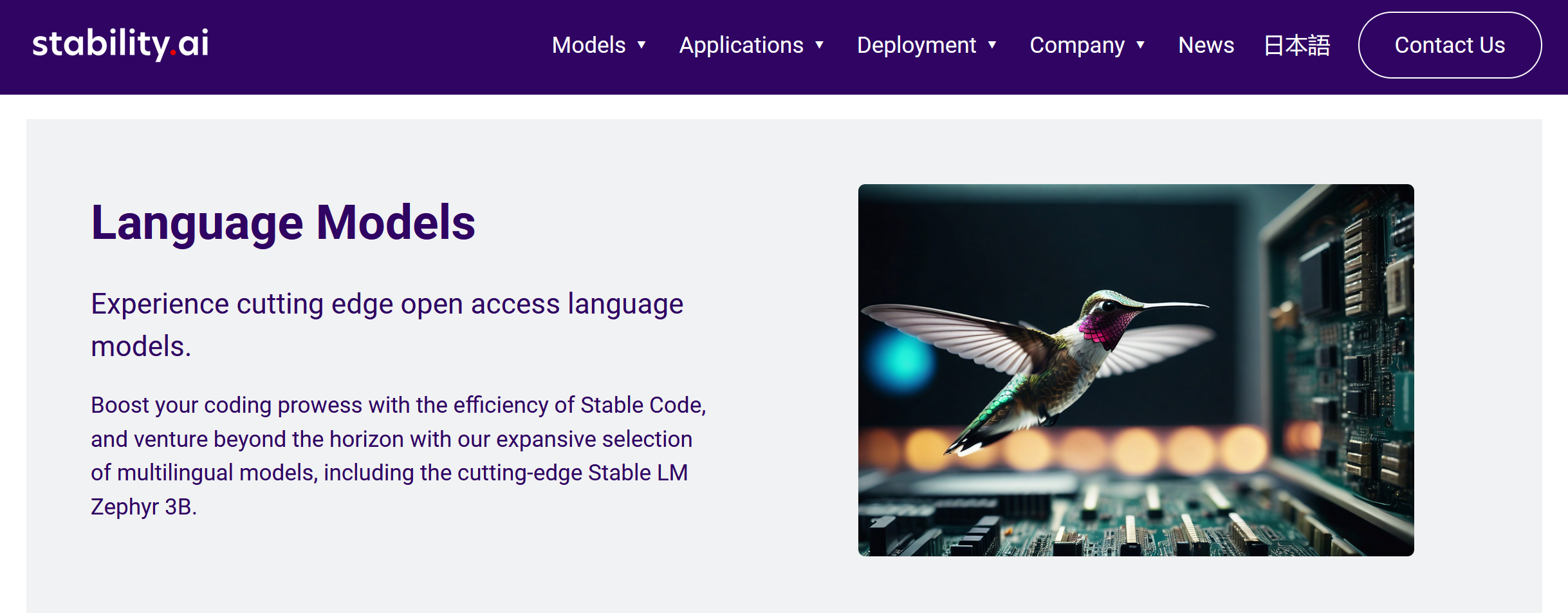Top positions in the ratings of the best AI generators of images, videos, and other online content are rightfully occupied by generative models of Stability AI. The company offers users a wide selection of AI products, each of which is publicly available. In this article, we will tell you how this startup appeared and is developing, what solutions it offers and where they are used. You will also learn about its prospects in the near future and, of course, how to use Stable Diffusion.
The Genesis of Stability AI
Stability AI is one of the key companies in the modern AI/ML industry, known for its open-source neural networks for working with images, video, audio, text, and code. The company's flagship product is the text/image-to-image artificial intelligence model Stable Diffusion. It generates high-quality realistic images from text queries in different languages and ready-made images.
Stability AI Stable's line-up also includes other products, including Stable Video Diffusion (video), Stable Audio (music and sound effects), Stable Video 3D/4D (3D and 4D objects), Stable LM 2/Zephyr/Beluga (text), and Stable Code/Code Instruct (code). The company allows developers to use their models to develop and test new systems, and also provides useful tools. For example, the Weka data platform optimizes GPU performance and speeds up the training of AI/ML algorithms.
The company was founded in 2019 by scientist and entrepreneur Emad Mostaque, who served as its CEO until March 2024. In 2020, three Stability AI specialists (Robin Rombach, Andreas Blattmann, Dominik Lorenz) developed the Stable Diffusion neural network, which creates images from text queries. The company became one of the first to make an AI image generator available to the mass user.

Stability AI's early years were funded by personal investments from its founder and CEO Emad Mostaque, along with contributions from individual investment companies (Eros Investments). In the fall of 2022, the AI startup raised $101 million from venture capitalists Coatue, Lightspeed Venture Partners, and O'Shaughnessy Ventures LLC. After that, its valuation reached an impressive $1 billion.
In March 2024, Emad Mostaque stepped down as CEO of Stability AI. Following his departure, the board of directors appointed two of its top managers, COO Shan Shan Wong and CTO Christian Laforte, as acting CEOs. Stability AI currently employs around 200 full-time employees. The company regularly updates existing AI models and releases new products. Its community of users and partners numbers over 300,000 creators, designers, developers, and researchers worldwide.
Core Technologies and Innovations
Over the years of its activity, Stability AI has released quite an extensive list of AI models. In this section, you will learn about their features and functions.
Stable Diffusion

Stable Diffusion is a text-to-image deep learning model released in 2022. The generative neural network is based on the latent diffusion method and trained on a huge amount of data containing billions of image-text pairs. The technology allows generating high-quality photorealistic images according to text cues entered by users. The latest version as of July 2024 is Stable Diffusion 3 with two billion parameters.
Key Features:
- The model creates images from scratch and modifies existing ones by adding new elements specified in the prompt. It can also paint and redraw images.
- Stable Diffusion is open source and distributed under a public license. Anyone can download it for free from the project's website or run it online.
- Its light weight allows the neural network to be launched on devices with video memory of 4 GB or more. This distinguishes it from more resource-intensive models such as Midjourney and DALL-E.
- Stable Diffusion also works in image-to-image mode, changing the content of ready-made images based on text prompts. The script outputs a new image based on the original, which contains the elements described in the prompt. Users can adjust the degree of image editing using the strength value parameter.
- This and other Stability AI neural networks are available without downloading to the user's device — through the online chatbot Stable Assistant.
And yet, is Stable Diffusion free? Yes, the full version of the model is completely free for anyone to use when running on local devices or a website. The developers charge a fee for using it through the API interface — $10 for 1000 credits, which is enough to create about 5000 SDXL 1.0 images.
In addition to the standard SD version, the company offers several advanced models based on it. Among them are Stable Diffusion XL (a more powerful SD modification with an expanded number of parameters) and SDXL Turbo (its accelerated version). In addition to them, this category includes:
- Japanese Stable Diffusion XL (text-to-image model that handles queries in Japanese)
- Japanese Stable VLM (a language model that creates Japanese prompts for AI image generation)
- Japanese Stable Clip (a feature extraction model for image retrieval and classification based on any Japanese text)
Stable Video Diffusion
The company's line of AI products continues with two models for video generation, known as Stable Video Diffusion (SVD). Both are capable of creating short (2-5 seconds) videos based on images or text queries. The first generates video content at 14 frames per second, and the second at 25 frames per second. Users can adjust this rate from 3 to 30 frames per second.


Stable Diffusion Video Generator is a modified latent diffusion model (LDM) trained on large image and video datasets. Fine-tuning the model allows improving the quality of videos and their compliance with the input data. SVD is also capable of synthesizing multiple images from a single source version. In tests, it outperformed image/text-to-video neural networks from Runway and Pika Labs.
Stable Audio
The next two models from Stability AI are designed for creating music and sound effects. The first is called Stable Audio 2.0, and it allows users to generate high-quality tracks up to three minutes long. Like other similar systems, the neural network creates original audio content based on audio samples and text prompts uploaded to it. The second is called Stable Audio Open, an open-source model for generating short samples, sound effects, and production elements via prompts. It can generate instrumental riffs, ambient sounds, Foley recordings, and other samples. The model was trained on copyright-free data from Freesound and Free Music Archive.
Stable Video 3D/4D/Zero123/TripoSR
Another group of neural networks from the developers of Stable Diffusion is designed to visualize objects in 3D and 4D. Stable Video 3D has two variants: SV3D_u creates orbital videos from a single image, and SV3D_p generates full 3D videos from both single and orbital images. Stable Video 4D turns 3D videos into dynamic 4D video content with a view from eight different angles. Stable Zero123 generates 3D objects with an accurate interpretation of their appearance from several perspectives. Stable TripoSR performs fast reconstruction of 3D objects.
Stable LM 2/Zephyr/Beluga
Stability AI’s products also include a number of language models. The flagship is Stable LM 2 12B, trained on 12 billion parameters and generating text in English, German, Spanish, Italian, French, Dutch, and Portuguese. The Stable LM 2 1.6B version with 1.6 billion parameters also processes text in the above-mentioned languages. The Stable LM Zephyr 3B chat model is configured to execute instructions and question-and-answer tasks. The Japanese Stable LM/Japanese Stable LM 2 1.6B models are trained on Japanese-language datasets and are considered one of the best LLMs in this language. Stable Beluga performs a wide range of text tasks — copywriting, answering general/scientific questions, searching for ideas, etc.
Stable Code 3B/Stable Code Instruct 3B

No less popular developments of the company are dedicated to programming. Stable Code 3B is a large language model with 3 billion parameters configured for accurate and fast code addition. Based on it, the Stable Code Instruct 3B model was released, generating code and solving mathematical and other problems.
Applications in Creative Industries
The diversity and versatility of the models released by Stability AI provide broad opportunities for using AI in creative industries. The company's products effectively automate creative activities, simplifying and accelerating the processes of creating all kinds and formats of content.
Among the most priority areas of application of its neural networks are the following:
- Stable Diffusion models can be used by visual effects editors.
- AI models allow you to create and edit images, videos, audio, text, and code much faster without special skills and tools.
- With their help, you can easily and quickly get original illustrations for websites, mobile applications, themes, magazines, books and other products.
- Stability AI neural networks help generate commercials, music videos and audio tracks, collages, image/video collections, etc.
- LLM are ideal for developing and editing text content, generating ideas and answering questions from various fields.
Challenges and Future Prospects
The open-source release of generative models has brought Stability AI not only popularity among hundreds of thousands of users, but also some problems. The company has been repeatedly accused of its products being used to create unwanted content with scenes of violence and pornography.
The famous image library Getty Images has filed a lawsuit accusing it of misusing more than 12 million photos from its collection to train the Stable Diffusion neural network. US lawmakers have called on intelligence agencies to deal with Stability AI models that do not moderate the content they create.
However, the legal battles with copyright holders do not prevent the company from regularly updating its existing neural networks and releasing new products. In the near future, it will have to solve a more important problem — namely, how to maintain financial stability through the commercialization of its open-source products.
A promising solution could be the paid AI chatbot Stable Assistant released by the company. It performs a wide range of operations, combining the functions of a number of the company's key developments: Stable Diffusion 3 Ultra, Stable Video, Stable Audio, Stable Image Services and Stable LM 2 12B. The chatbot is available to users via a web interface; to work with it, you need to buy a subscription priced from $9 to $99 per month.
Conclusion
Stability AI has revolutionized creative industries with its Stable Diffusion AI image generator and its modification Stable Diffusion video generation. The company's products have had a huge impact on designers, artists, illustrators, video makers, and other content creators around the world. The audience has highly appreciated not only the rich functionality of Stability AI neural networks, but also their mass availability. In fact, the developers have introduced some of the first text/image-to-image/video models with open-source code. Anyone can use them for any purpose without the obligatory purchase of a license.
